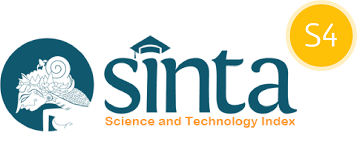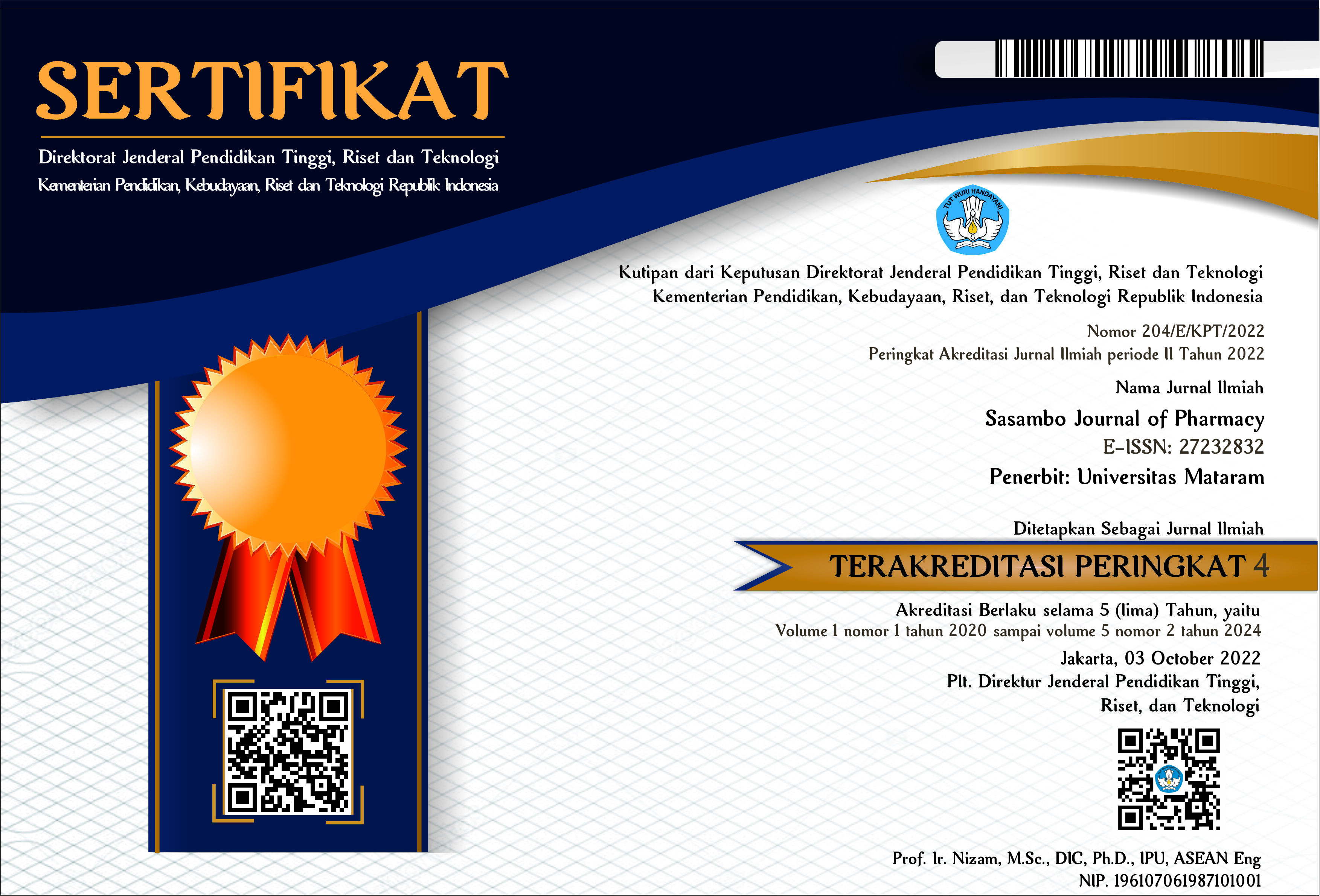Profil fitokimia dan aktivitas antibakteri fraksi etil asetat akar jarak pagar (Jatropha curcas Linn.)
DOI:
10.29303/sjp.v2i2.116Downloads
Abstract
Bacterial infections are a major cause of chronic infections and mortality that continues to threaten public health worldwide. Various medicinal plants used in folk medicine have demonstrated wound healing and antibacterial properties. The aims of the study are investigation phytochemical and antibacterial activity of ethyl acetate fraction from jarak pagar roots (Jatropha curcas Linn.). The roots were treated with maceration method using ethanol 70% and subsequently fractioned to ethyl acetate fraction. The fractions were used for phytochemical screening and antibacterial assay using Kirby and Bauer agar difussion method. The results showed that ethyl acetate fraction jarak pagar roots contained alkaloid, flavonoids, saponins, steroids, poliphenol dan tannins. The antibacterial activity of jarak pagar roots againts Staphylococcus aureus and Escherichia coli shows that the activity of this fraction with concentration 8 mg/mL has strong inhibitory potency against the growth S. aureus with inhibitory zone is 14,3 mm and has moderate inhibitory potency against E. coli with inhibitory zone is 9 mm. The increase concentrations of ethyl asetate fraction jarak pagar roots shows high inhibition diameter of bacterial growth.
Â
Â
Keywords:
ethyl acetate fraction, jarak pagar roots, antibacterial activityReferences
Askira, M. (2012). Acute Toxicity, Phytochemistry and Antibacterial Activity of Aqueous and Ethanolic Leaf Extracts of Cassia alata Linn. International Research Journal of Pharmacy, 3(6), 73-76.
Bibitha B, Jisha VK, Salitha CV, Mohan S, Valsa AK. (2002). Antibacterial activity of different plant extracts. Short Communiaction.Indian Journal Microbiologi, 42(3), 361-363.
Hodek, (2002). Flavonoids- potent and Versatile Biologically and Active Compounds Interacting with Cytochrome P450. Chemico- Biol. Intern. 3(1), 10-15.
Igbinosa, O.O., Igbinosa, E.O., Aiyegoro, O.A., (2009). Antimicrobial Activity and Phythochemical Screening of Stem Bark Extracts from Jatropha curcas (Linn.), African Journal of Pharmacy and Pharmacology. 3(2), 58-62.
Indijah, S.W., & Fajri, Purnama. (2016). Farmakologi. Jakarta : Pusdik SDM Kesehatan, Badan Pengembangan dan Pemberdayaan Sumber Daya Manusia Kesehatan. Kementerian Kesehatan Republik Indonesia.
Jawetz, E., Melnick, J. L., dan Adelberg, E. A. (2001). Mikrobiologi Kedokteran, Edisi XXII, 317-327, Penerbit Salemba Medika, Jakarta.
Latif, R.A., Defny, S.W., dan Henki, R., 2015, Uji Daya Hambat Organisme laut Spons Amphimedon sp. Terhadap pertumbuhan Bakteri Staphylococcus aureus, Escherichia coli, Dan Jamur Candida albicans, Jurnal Ilmiah Farmasi, 8(3).
Mothana A.R., dan Lindequist U. (2010). Antimicrobial of some medical plants of the island Soqotra. Journal of Ethnopharmacology. 6(9), 117-123.
Mujumdar A.M and Misar A.V. (2008). ‘Anti-inflammatory Activity of Jatropha curcas Roots in Mice and Rats’. Journal of Ethnopharmacology. 42(9), 11-15.
Nurmillah, Ovi Yulianti, Liyana, Pathiranan, F. Shahidi. (2011). Isolasi dan Identifikasi Senyawa Kimia Ekstrak akar Tanaman Jarak Pagar (Jatropha Curcas Linn.) serta Uji Aktivitasnya Sebagai Antibakteri dan Antifungi. Journal of Applied Microbiology, 7(2), 142-148.
Nurmuhaimina, Suyana Asri., Maulina Resna., Yuniarti, Isnani., Umaningrum, Dewi. (2009). Uji Aktivitas Antioksidan Dari Ekstrak Campuran Tumbuhan Alang-Alang (Imperata cylindrica) Dan Lidah Ular (Hedyotis corymbosa) Sebagai Peredam Radikal Bebas Asam Linoleat. Skripsi FMIPA UNLAM Banjarbaru Kalimantan Selatan. 4(1), 85-92.
Rugayah, (2009). Keanekaragaman Tumbuhan dan Potensinya di Cagar alam Tangale, Gorontalo. Jurnal Teknologi Lingkungan. 10(2), 21-27.
Ruslin dan Sahidin. (2008). Identifikasi dan determinasi tanaman obat tradisional masyarakat Sulawesi Tenggara pada Arboretum Prof. Mahmud Hamundu Universitas Haluoleo. Majalah Farmasi Indonesia, Vol. 19 No. 2:101–107.
Sharma, A.K., Gangwar, M., Tilak, R., Nath, G., Sinha, A.S.K., Tripathi, Y.B. dan Kumar, D. (2012). Comparative in vitro antimicrobial and phytochemical evaluation of methanolic extract of root, stem and leaf of Jatropha curcas Linn. Journal of Pharmacognosy. 4, 34-40.
Tjay, T. H., & Rahardja, K. (2015). Obat-Obat Penting Edisi Ketujuh. Jakarta : Elex Media Komputindo Kelompok Gramedia.
Ventola, C.L. (2015). The Antibiotic Resistance Crisis ‘Causes and Treaths’. 40(4), 277-283.
Windarwati, (2011). Uji Aktivitas Antioksidan Ekstrak Metanol Daun Tumbuhan Jarak Pagar (Jatropha curcas Linn.) Skripsi. Hal. 50-52. Fakultas MIPA Universitas Halu Oleo.
License
Authors who publish with Sasambo Journal of Pharmacy (SJP), agree to the following terms:
- Authors retain copyright and grant the journal right of first publication with the work simultaneously licensed under a Lisensi Creative Commons Atribusi 4.0 Internasional. This license allows authors to use all articles, data sets, graphics and appendices in data mining applications, search engines, web sites, blogs, and other platforms by providing an appropriate reference. The journal allows the author(s) to hold the copyright without restrictions and will retain publishing rights without restrictions.
- Authors are able to enter into separate, additional contractual arrangements for the non-exclusive distribution of the journal's published version of the work (e.g., post it to an institutional repository or publish it in a book), with an acknowledgment of its initial publication in Sasambo Journal of Pharmacy
- Authors are permitted and encouraged to post their work online (e.g., in institutional repositories or on their website) prior to and during the submission process, as it can lead to productive exchanges, as well as earlier and greater citation of published work (See The Effect of Open Access).







